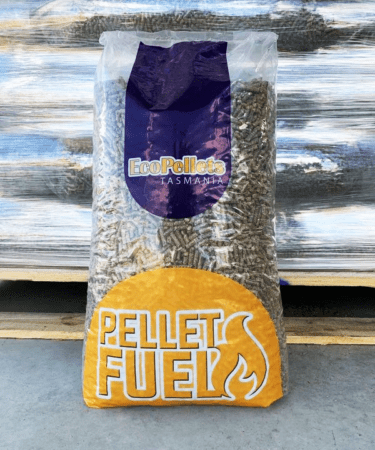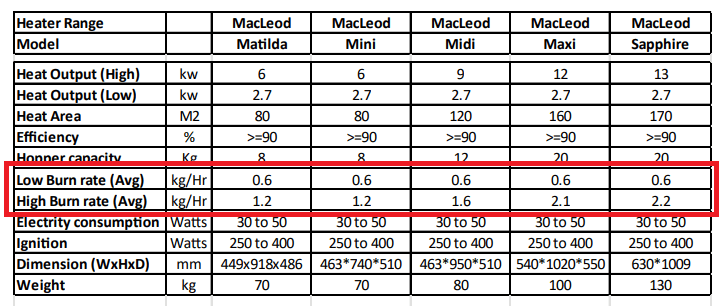A 15kg bag of pellets typically lasts between 6 to 25 hours of continuous burning in most Australian pellet heaters. However, the exact duration depends on your heater’s size, heat settings, house insulation, and local climate conditions. Understanding these factors will help you calculate your pellet consumption and plan your winter heating costs effectively. This makes it easy to determine how much it costs to run your pellet heater.

Quick Answer: Pellet Consumption Rates
The general rule of thumb for Australian pellet heaters is that 1kg of pellets burns for approximately 1 hour on average settings. This means your 15kg bag of wood pellets should provide:
- Low heat setting: 20-25 hours of burning
- Medium heat setting: 12-15 hours of burning
- High heat setting: 6-10 hours of burning
Most Tasmanian households would use 1 bag every 2 or 3 days during winter, depending on their heating requirements and home efficiency. If you live outside of Tasmanian then it will vary depending on which state you are in and how long and cold your winters are. Read on below to understand what impacts how long a bag of pellets burn or check out my wood pellet guide for more tips and tricks on buying, storing and understanding wood pellets.
How Heater Size Affects Pellet Consumption
Heat Output and Burn Rates
Pellet heaters in Australia range from compact 3kW units to large 13kW models. The higher the heat output, the more pellets your heater consumes per hour. Below is an average of the kind of wood pellet consumption based on how many kilowatts of heat your pellet heater can put out:
Small pellet heaters (3-6kW):
- Burn rate: 600-1,200 grams per hour
- 15kg bag duration: 12.5-25 hours
- Suitable for: Small homes, single rooms, mild climates
Medium pellet heaters (7-10kW):
- Burn rate: 1,000-1,800 grams per hour
- 15kg bag duration: 8-15 hours
- Suitable for: Medium homes, open-plan living areas
Large pellet heaters (11-13kW):
- Burn rate: 1,500-2,200 grams per hour
- 15kg bag duration: 6.8-10 hours
- Suitable for: Large homes, very cold climates, poorly insulated houses
Understanding Your Heater’s Specifications
Check your pellet heater manual for specific pellet consumption rates. Most Australian brands like Piazzetta pellet heaters, Palazzetti heaters, and other brands provide detailed consumption charts showing grams burned per hour at different heat levels. Below is information from Pellet Fires Tasmania and the burn rate specifications for models they sell:

For example, a typical Australian pellet heater might consume:
- Level 1 (Low): 600g/hour = 25 hours per 15kg bag
- Level 3 (Medium): 1,200g/hour = 12.5 hours per 15kg bag
- Level 5 (High): 2,000g/hour = 7.5 hours per 15kg
Temperature Settings and Usage Patterns
Thermostat Operation
Modern pellet heaters with thermostats automatically adjust pellet feed rates based on your set temperature. This significantly impacts how long your pellets last. Basically, the lower you set this the longer a bag of pellets will last. Obviously you need to balance comfort with savings. Nobody likes to be cold.
18-20°C setting: Heater runs mostly on low, maximising pellet efficiency 21-23°C setting: Balanced operation between low and medium heat 24°C+ setting: Frequent high-heat operation, consuming pellets rapidly
Room Size Considerations
The area you’re heating dramatically affects pellet consumption. You’ll burn through more pellets if trying to heat a large area to a high temperature:
- Single room (20-40m²): 15kg bag lasts 2-3 days
- Open-plan area (60-100m²): 15kg bag lasts 1-2 days
- Whole house heating: 15kg bag lasts 12-24 hours
House Insulation: The Biggest Factor
Well-Insulated Homes
Modern Australian homes with proper ceiling, wall, and floor insulation can extend pellet burn time. This is because the insulation helps retain the heat, meaning your pellet heater won’t switch into high heat mode as often to bring the room or area back up to your desired temperature. Good insulation means:
- Less heat loss through walls and ceilings
- Reduced cold air infiltration
- More consistent indoor temperatures
- Lower pellet consumption overall
Poorly Insulated Homes
Older Tasmanian and Australian homes, particularly those built before modern building codes, can dramatically increase pellet consumption:
- Single-glazed windows lose significant heat
- Poor door and window seals allow cold air in
- Inadequate ceiling insulation increases heat loss
Insulation Improvements Worth Making
Before getting any pellet heater, I strongly recommend you take a look at your home and how well it is or isn’t insulated. Doing any of the below will reduce your pellet heater running costs and make a bag of wood pellets last longer:
- Draught proofing: Seal gaps around doors and windows
- Ceiling insulation: Add or upgrade to R3.5-R6.0
- Curtains and blinds: Thermal curtains reduce heat loss
- Door snakes: Simple but effective draught stoppers
These improvements often pay for themselves quickly because you’ll be reducing pellet consumption and pellet heater running costs.
Annual Pellet Usage and Costs
Seasonal Planning for Australian Climates
Where you live also impacts how long a bag of pellets lasts. Below I’ve tried to provide a good estimate of how many bags of pellets you’ll go through each year depending on where you live. However, take this and the running costs with a grain of salt because it depends on many factors.
Mild climate zones (Brisbane, Perth, coastal areas):
- Winter usage: 30 – 60 bags per year
- Daily usage: No more than half a bag per day
- Season cost: $450 – $900
Moderate climate zones (Sydney, Melbourne, Adelaide):
- Winter usage: 30 – 60 bags per year
- Daily usage: No more than half a bag per day
- Season cost: $600 – $900
Cold climate zones (Canberra, Tasmania):
- Winter usage: 80-150 bags per year
- Daily usage: 3/4 to 1.5 bags a day
- Season cost: $800 – $1,600
Pellet Quality and Storage Factors
Proper Storage for Maximum Efficiency
Moisture is pellets’ biggest enemy. Store your wood pellets correctly to keep them dry. Wet pellets do not burn well and can even jam your pellet heater auger. Much like you don’t burn wet firewood, you shouldn’t burn wood pellets that haven’t been stored correctly and kept dry. Read my how to store wood pellets post if you’d like to learn more:
- In a dry shed or garage
- Off the ground on pallets
- Away from direct sunlight
- In sealed containers if possible
Wet pellets:
- Expand and can jam your auger
- Burn inefficiently with less heat output
- Create more ash and clinkers
- May damage your pellet heater
Properly stored pellets maintain quality at least 12 months in Tasmanian and Australian conditions. Most wood pellet manufacturers advise to not keep pellets longer than 12 months, but I personally have no problem storing and burning pellets for up to two years.
Maintenance Impact on Pellet Consumption
Regular Cleaning for Efficiency
Keep your pellet heater clean and you’ll get a much better burn time, making a bag of pellets last longer. I like to empty my burn pot daily but it does depend on the quality of pellet you are burning. However, pellet heaters need to be cleaned and serviced annually. If you don’t know how or don’t want to service and clean your pellet heater then it pays get someone else to do it.
Daily maintenance:
- Empty burn pot
- Clean glass door
Weekly maintenance:
- Empty ash pan
- Vacuum out burn box
- Check pellet hopper for dust
Monthly maintenance:
- Clean heat exchanger tubes
- Check door seals and gaskets
- Inspect exhaust vent
- Clean fan and air intake
Annual service:
- Vacuum out exhaust chambers
- Clean heat exchanger
- Clean out flue
- Change auger bearings
Well-maintained heaters can use fewer pellets than neglected units because they burn more efficiently and product more heat.
Feed Rate Adjustments
Only qualified technicians should adjust feed rates. Feed rates impact how many pellets are fed into the burn pot and impacts how long a bag of pellets last. Generally speaking, higher feed rates burn pellets faster than lower feed rates. Incorrect settings can cause:
- Too high: Pellet waste, clinkers, dangerous overheating
- Too low: Poor heat output, frequent fire extinction
Climate Considerations for Australia
Regional Variations
As I mentioned above where you live in Australia will also impact how long a bag of pellets lasts because you just won’t need to run your pellet heater as much. Everyone is different and what you think is cold I may not, but generally speaking the further north in Australia you live the fewer bags of pellets you’ll go through each year.
Northern Australia (Queensland, Northern NSW/WA):
- Shorter heating season
- Lower daily consumption
Southern Australia (Victoria, Tasmania, SA, ACT):
- Longer heating season
- Higher daily consumption during peak winter
Wind and Weather Impact
Winter might be cold but the type of day will also impact how long you run your heater and obviously how long a bag of pellets lasts:
- Windy days: May be higher due to wind chill factor
- Sunny winter days: Natural solar gain may reduce how long you run your heater
Troubleshooting Poor Pellet Efficiency
Signs Your Pellets Aren’t Lasting Long Enough
- Burning more than 2 bags per day
- Frequent high-heat operation even in mild weather
- Excessive ash production
- Inconsistent room temperatures
Common Causes and Solutions
Problem: Rapid pellet consumption
Causes: Poor insulation, oversized heater, incorrect thermostat placement
Solutions: Improve insulation, relocate thermostat, professional assessment
Problem: Inconsistent burn times
Causes: Poor pellet quality, moisture in pellets, dirty heater
Solutions: Switch pellet brands, check storage, professional cleaning
Frequently Asked Questions
How many 15kg bags do I need for winter?
Most Tasmanian homes will go through about 60 to 80 bags a year and other Australian homes anywhere from 30 to 60 bags a year. This all depends on climate zone, house size, and insulation quality. I’d start out by buying 10 or so bags of pellets and see how long it lasts you.
Can I leave pellets in the hopper?
There’s no problem leaving pellets in the hopper throughout summer. I just wouldn’t keep pellets outside in winter for too long, even if they are under cover. By this I mean pellets that haven’t been kept in their plastic bags.
What’s the difference between hardwood and softwood pellets?
This is a highly debated topic of hardwood vs softwood pellets with some people saying softwood pellets often burn hotter and produce more heat per kg, while hardwood pellets typically burn longer with less ash. However, for me I think they both the same and you should focus on pellet price and quality instead. Depending on where you live Bunnings wood pellets and Mitre10 wood pellets are both hardwood pellets and burn extremely well with minimal ash.
How do I store pellets long-term?
Store in a dry location off the ground, ideally in sealed containers. Properly stored pellets are good to burn for at least 12 months and I personally burn them for up to 24 months later and longer.
Why is my heater using more pellets than expected?
Common causes include feed rate is wrong and doesn’t match the length of pellets you are burning, poor house insulation, incorrect thermostat settings, dirty heater components, or wet pellets. Start with a professional service and insulation assessment.
Summary: Maximising Your Pellet Efficiency
A 15kg bag of pellets will serve you well when you understand your heating needs and optimise your setup. Remember:
- Insulation is your best investment – it can reduce your pellet consumption
- Regular maintenance keeps your heater running efficiently
- Quality pellets stored properly burn better and last longer
- Realistic expectations – in Tasmania half to one bag a day and other states up to half a bag a day in winter
Resources
Quadrafire pellet burn time information
